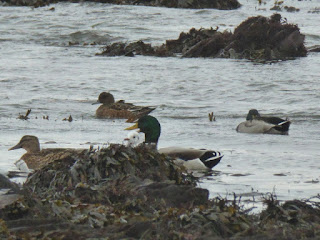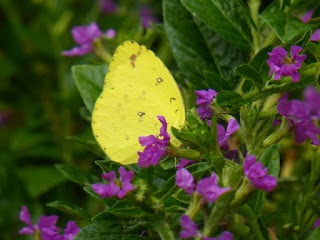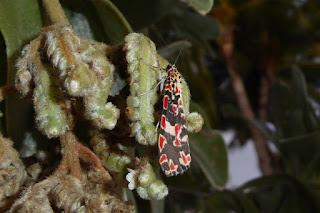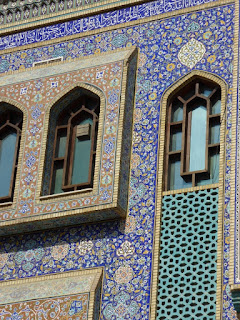Mauritius was a late choice for this years holiday due to a lack of inspiration for where to go. I had noticed an advert for a holiday to Mauritius in the back of a newspaper which started things off and my Mum had been there a few years ago and had said how nice it was and that I would enjoy the colourful birdlife ( I should have done a bit more research though, the colourful birdlife were good numbers of quite tame introduced birds of just a few species). Davids Aunty had also lived there for a while back in the 1970's and had also said how nice it was and so we booked up to go without really doing a lot of planning or research beforehand. The long flight was something we weren't looking forward to either and so on the way back to the UK we added on a stopover in Dubai to break the journey up.
Black River Gorge National Park, Mauritius
An appalling Emirates check-in clerk at Heathrow Airport didn't start things off well - unhelpful, disinterested and a couldn't be bothered attitude, not what I expected especially when she casually informed me that I was on standby for the flight from Dubai to Mauritius but David was booked all the way through!!!!! She even asked me if I wanted my luggage checked through to Mauritius - of course I did - and did I want to join the Emirates frequent flyer club! It was eventually sorted out but really pissed me off and was a shame because the rest of my experience with flying Emirates was excellent.
Anyway, we eventually arrived at the Hotel Pirogue in Wolmar on the west coast of Mauritius after a 28 hour journey door to door and settled in quickly. It was dark on arrival at the hotel but I had seen my first bird on arriving at the airport as the sun was setting - a common myna - and on waking up the next morning there were colourful birds everywhere including more common mynas. However all the birds I was seeing had been introduced to Mauritius and were not quite as exciting to me because of this - David found my attitude towards them a little odd as they were now wild birds and it did make me think about why I looked at them with less enthusiasm. I realised that the introduced spotted doves I was seeing had been introduced in 1781, earlier than little owls were introduced to the UK, and I get excited about seeing them in the UK. I also get excited at seeing the introduced red kites from the train on the journey to London and so I was surprised at my snobby attitude to a birds provenance but I eventually grew to appreciate all the birds I was seeing.

The view from the room in Mauritius
Mauritius was lovely - beautiful hotel on a beautiful beach, mostly sunny weather, not too hot with cloudy and showery spells and a cooling breeze, lots of greenery, some mountainous scenery, a very laid back attitude and some enjoyable laid back birding.
Green backed Heron
Green backed Heron - ready to strike
Green backed Heron - success!
Green backed Heron - struggling to swallow its catch
I managed to see 29 species of birds, surprisingly low considering being in the Tropics, but the ecosystem of Mauritius was totally trashed when settlers arrived (remember the dodo) and without the introduced birds there would have been very little birdlife to look at. I also did no real birding, having taken my small travelling Leica binoculars with me and not my large and heavy Swarovskis, but it was quality if not quantity.
Birds seen were :- common myna, Madagascar red foddy, spotted dove, feral pigeon, house sparrow, common waxbill, village weaver, house crow, Egyptian goose, Madagascar turtle dove, barred ground dove, mallard, red whiskered bulbul and grey francolin - all introduced - and green backed heron, moorhen, white tailed tropicbird, whimbrel, turnstone, Mauritius bulbul (endemic), Mascarene swiftlet, Mascarene martin and Mauritius grey white eye (endemic) - all native.
Common Myna
Barred Ground Dove
Village Weaver
Grey Francolin
Madagascar Turtle Dove
Red-whiskered Bulbul
Mauritius Grey White-eye
Madagascar Red Fody
Other birds seen were :- 2 parakeets flying over the car near the hotel (probably ring necked); probable laughing doves flying around the capital Port Louis (seen from the bus); sea birds offshore, frustratingly distant, but lots of shearwaters (probably wedge tailed) flying north in the evenings before sunset and a few south in the early mornings; large gannet like birds in spectacular dives, probably boobies; large white terns diving closer to shore (Caspian or lesser crested?); and large, black, angular looking birds flying north at dusk in 1's and 2's, like a cross between a tern and a skua and probably frigate birds or noddies. Also seen were 2 waders with a small flock of turnstone flying along the reef at dusk, noticeably smaller than the turnstones but with no plumage detail due to distance and low light, probably sanderling or curlew sandpiper.
Bird highlights were :- feeding the colourful birds on our room veranda in the mornings with bread rolls snaffled from the breakfast buffet, allowing some very close views and with barred ground doves feeding from our hands; seawatching in the evenings, frustrating due to light and distance but I did manage to find a pod of spinner dolphins swimming past and spinning out of the water; Mascarene martins nesting in the roof rafters of the boat jetty on the beach; white tailed tropicbirds soaring over the forested mountains in the Black River Gorge National Park; and finding a Mauritius bulbul in the trees near the Hindu shrine at Grand Bassin, an uncommon endemic to the island and one I didn't expect to see.
"Lovey-Dovey / Birdy"
Mascarane Martin
Spotted Dove
Mauritius Bulbul
Madagascar Red Fody
Barred Ground Dove
I didn't get to see pink pigeons and Mauritius kestrel, both endangered endemics to the island, but I didn't really look for them. I have seen them in Jersey zoo where they were being bred to be released on the island as part of a captive breeding program - my birding snobbery coming to the fore again.
The overall highlight for me though were the dolphins. We went on a boat trip to swim with them early in the morning and it was a wonderful experience but it did leave me a little uneasy come the end. A pod of spinner dolphins and bottle nose dolphins rest overnight in shallow bays inside the reef along the coast near our hotel and we set off at 7am to find them before they head off out to sea to feed. We were the first boat to arrive at the bay where they were resting and 5 of us entered the water to snorkel with them. They were very inquisitive and came very close at times, almost close enough to touch, and I even watched a pair mating, catching a glimpse of dolphin penis (!). I swam through their air bubbles as they wobbled through the water to the surface and also swam through some dolphin poo - lovely. Their clicking was very noticeable at times and the whole experience was amazing and surreal.
Bottle Nose- and Spinner Dolphins
Spinner Dolphin
Spinner Dolphin
Spinner Dolphins
Spinner Dolphin
However more boats began to arrive and it started getting a bit out of hand. I surfaced to find a boat very close to me with 10+ people on board yelling and shouting and leaping in to the water and so I decided to get back on my boat. The dolphins became more elusive and kept swimming away from the boats with one animal doing a lot of tail slapping, not a happy dolphin, and so we left and headed back to the hotel. I was glad to have had the experience and our boat operator had followed all the guidelines by letting the dolphins come to us rather than chase after them but unfortunately the other boats that arrived were not so conscientious, and I worry about the long term effects that uncontrolled and unregistered operators may have on the animals.
Other sightings included lots of very fast and colourful and active butterflies including what looked like monarch butterflys, mongoose (introduced), colourful lizards, toads, terrapins, flying foxes, Utetheisa cruentata moths that looked like larger and darker crimson speckleds (same family), Java deer (introduced) and long tailed macaque monkeys (introduced).
Brilliant Blue
Lang's Short-tailed Blue
Broad Bordered Grass Yellow
Lang's Short-tailed Blue
Dragonfly sp.
Giant Lily, Pampelmousses Botanical Garden
Flying Fox
Toad sp.
Utetheisa cruentata
Long tailed Macaque
Long Tailed Macaque
Damselfly sp.
Shore Crab sp.
Shore Crab sp.
Utetheisa cruentata
Mauritius was an amazing and interesting experience, certainly quality wildlife if not quantity, and I would certainly like to visit again although it is such a long way away. And so on the way home we stopped off in Dubai for 2 nights to break up the long flight and to see the Burj Khalifa, the current highest building in the world.
Dubai was interesting, I wasn't really looking forward to the visit but it was actually quite good. We only had a full day there due to flight times and so it was a whistle stop 24 hours in Dubai but we managed to see and do quite a bit. We went up to the 148th floor of the Burj Khalifa (£95 each!) but it was worth it for the view and the experience and walking around the old district of Deira was interesting although it was incredibly hot and sweaty, unlike Mauritius.
Bizarrely I managed to see 15 species of birds in that 24 hours without even trying! Collared doves, laughing doves, feral pigeons, common mynas and house sparrows were seen from the rooftop swimming pool at the hotel which overlooked the creek with a distant view of the Burj Khalifa. On a boat trip across the creek I saw a whimbrel fly past, a Socotra cormorant drying its wings on a buoy and variously aged large herring-gull like gulls flying over, probably Caspian. A pied myna, 2 Indian silverbills, a graceful prinia, red vented bulbul, white eared bulbul, house crow and a swallow sp. overhead were also seen, not bad at all considering the heat and a very urban environment although again most of these species have been introduced.
Burj Khalifa skyline from the hotel pool, Dubai
Pied Myna
Socotra Cormorant
Indian Silverbill
Collared Doves and Feral Pigeons
Iranian Mosque
Burj Khalifa
And so back to the reality of cold, wet and windy Plymouth, back to work to pay for it all and a diet after 9 days of half board buffets in Mauritius but it had been a very relaxing and enjoyable holiday - and we got to see a dodo skeleton in the national musueum in Port Louis as well.
Dodo
Dodo










































































